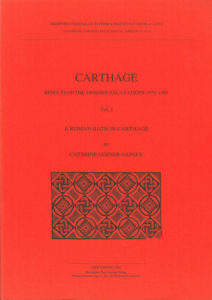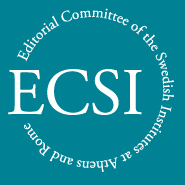Carthage
 Carthage I. Results of the Swedish excavations 1979–1983. A Roman bath in Carthage
Carthage I. Results of the Swedish excavations 1979–1983. A Roman bath in Carthage
Now available for purchase at Astrom Editions, Amazon.com, and Amazon.de.
By Cathrine Gerner Hansen. With foreword by Birgitta Sander and Carl-Gustaf Styrenius and contributions by Serge Lancel and Gudrun Anselm
This volume contains the architectural descriptions and analyses of the ruin found by the Swedish Mission to Carthage, SMC, during 1979–1980 within the Unesco programme Pour Sauver Carthage. An archaeological report will follow. The main plot, Site A, which was placed at the disposition of the SMC is located at the foot of the northern incline of Byrsa in the triangle between avenue de la Republique (now avenue de I’ Amphitheatre) and rue Mendes France. Since the excavations were established on the highest point of the saddle between the two Carthaginian heights Byrsa and Juno it was entirely unexpected when the remains of a Roman bath complex were revealed.
The finds essentially confirm Saumagne’s theories regarding the layout of Roman Carthage. The main and best preserved remains, labelled Complex II, were part of lnsula 101 E making up the corner between the Cardo I E and Decumanus I N. Approximately 620 m2 of the building, hypothetically dated to originate from the period between the middle of the 2nd and the end of the 5th century AD, were unearthed. It enclosed an eastern bath section ascribed to the original layout of the complex and a smaller western bath section belonging to a secondary phase. Besides the two hypocausts eight cisterns and over forty channels could be traced.
When Complex II was constructed, this was accomplished without any regard for the earlier Complex I, which was demolished down to a level at which it could be hidden by the new building. Complex I is presumed to belong to the Augustan revival of the town. Few walls were found below the level of the paving of Complex II and they are insufficient to reveal the plan or functions of this complex.
Traces of a grave and the bottom of a Punic cistern are the most convincing remains from the Punic period. These few traces also confirm the hypothesis that a transition of the area from necropolis to residential area took place in the 2nd century BC, leaving a very short period of existence for Punic habitation before the Roman conquest in 146 BC.
Bibliographical information
Cathrine Gerner Hansen, Carthage. Results of the Swedish excavations 1979–1983. A Roman bath in Carthage (Skrifter utgivna av Svenska Institutet i Rom, 4°, 54:1), Stockholm 2002. ISBN: 91-7042-158-7. Softcover: 130 pages & 8 fold-out plans.
Review
Journal of Roman Archaeology 17, 2004, 647-650 (J.J. Rossiter)
![Front cover of John Lund, Rita Larje & Harald Nilsson, Carthage II. The Swedish Mission to Carthage. Part of the UNESCO Project “Pour Sauver Carthage” (Skrifter utgivna av Svenska Institutet i Rom, 4°, 54, vol. 2), Stockholm 2017 [2018]. ISSN: 0081-993X. ISBN: 978-91-7042-185-3. Hardcover: 235 pages.](https://ecsi.se/wp-content/uploads/2018/03/2017_ActaRom4_54_2_801x1024-235x300.jpg) Carthage II. The Swedish Mission to Carthage. Part of the UNESCO Project “Pour Sauver Carthage”. Results of the Swedish excavations 1979–1983
Carthage II. The Swedish Mission to Carthage. Part of the UNESCO Project “Pour Sauver Carthage”. Results of the Swedish excavations 1979–1983
Distributed by Eddy.se AB. Also available at Amazon.com, Amazon.de, Bokus.com, and Adlibris.com.
By John Lund, Rita Larje and Harald Nilsson, with contributions by Maria Vretemark. Foreword by Kristian Göransson and epilogue by Birgitta Sander
This second and final volume on the Swedish participation in the UNESCO project “Pour Sauver Carthage” 1979–1983 presents three detailed studies of excavated material from the Swedish main Site A at Carthage: terracotta lamps, animal bones and coins. The site is situated in central Carthage on the highest point of the saddle between the Carthaginian heights Byrsa and Juno. Excavations unearthed somewhat unexpectedly a building complex with a small Roman and Late Antique bath. Approximately 7000 finds were registered, and of them only the three categories presented in this volume have been analyzed in their entirety. They show that the latest building complex was used through to the 7th century AD. Circa 893 (mainly fragments of) terracotta lamps found at Site A are published and analytically studied in Chapter 1. A large amount of bones from mammals, birds and fish are studied and analysed in Chapter 2. The catalogue of the coinage in Chapter 3 contains description of coins from the Swedish excavations at Site A and B. Of 1281 discovered coins 508 coins are considered identifiable and discussed here with photographs. Epilogue of this volume presents a summary of the excavation and its results.
Contents
Abstract
Kristian Göransson | Foreword
John Lund | Terracotta lamps from the Swedish excavations at Carthage
Rita Larje | Animal bones from the Swedish excavations at Carthage. With contribution by Maria Vretemerk
Harald Nilsson | Coins from the Swedish excavations at Carthage
Birgitta Sander | Epilogue
Bibliographical information
John Lund, Rita Larje & Harald Nilsson, Carthage II. The Swedish Mission to Carthage. Part of the UNESCO Project “Pour Sauver Carthage” (Skrifter utgivna av Svenska Institutet i Rom, 4°, 54, vol. 2), Stockholm 2017 [2018]. ISSN: 0081-993X. ISBN: 978-91-7042-185-3. Hardcover: 235 pages.
Reviews
Journal of Roman Archaeology 33, 2020, 805-808 (Jeremy Rossiter)
L’Antiquité Classique 89, 2020, 368-370 (Alexandre Wimlot)
Revue Archéologique 2019:1, 228-229 (Fathi Bejaoui)

No Comments
Comments are closed.